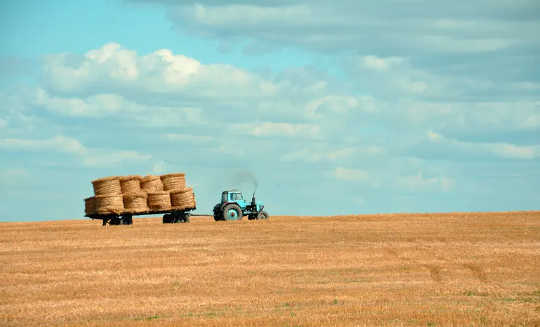Ecosystem degradation is a global phenomenon. It is expected that by 2050, 95% of Earth’s land will be degraded. A whopping 24 billion tons of soil have already been eroded by unsustainable agricultural practices. This land degradation is the leading cause of losses of ecosystem functions such as nutrient cycling and climate regulation. These functions sustain life on Earth.
It is recognised that this constitutes a crisis. At a UN summit this September, more than 70 world leaders – bar those from the US, China or Brazil – signed the Leaders’ Pledge for Nature, promising to clamp down on pollution, eliminate the dumping of plastic waste and strengthen environmental agreements worldwide. This is a good step, but as UN Deputy Secretary-General Amina Mohammed noted at the event, to “rescue the planet’s fragile tapestry of life, we need vastly more ambition and action”.
4.7 million hectares of forests are lost every year.
Ecosystems support all life on Earth. Protecting them can help end poverty, combat the climate crisis & prevent a mass extinction.
More from @UNEP: https://t.co/UDP3ciWLHh #GenerationRestoration #ForNature pic.twitter.com/VgWgyhCJUK— UNESCO (@UNESCO) October 4, 2020
Next year will mark the start of the UN Decade on Ecosystem Restoration, aimed at addressing the enormous task of restoring degraded habitats across the planet. Against a backdrop of ecological crisis, this declaration is a chance to revive our life support system – the natural world. The UN has highlighted several important actions to empower a global restoration movement, such as investment in restoration and research, celebrating leadership, shifting behaviours and building up the next generation.
There is no doubt this is an ambitious plan. But it must be translated into action. Such pledges can actually work against action by creating the illusion that something is being done. There is often a gap between rhetoric and reality. Indeed, the world’s nations have failed to fully achieve any of the 20 global biodiversity targets set by the UN a decade ago. Humanity is at a crossroads. What we decide to do now will affect many future generations to come.
New research is constantly demonstrating the urgency of the situation. One recent study focusing on the consequences of indiscriminate deforestation, for example, suggests we have a less than 10% probability of surviving the next 20-40 years without facing a catastrophic collapse if we remain on our current trajectory.
Here, I summarise four key reasons why ecological restoration is the most important endeavour of our time. If we are to reverse the ecological crisis that we are currently facing, and protect biodiversity for itself and for future generations, we must turn pledges into immediate action and restore our ecosystems on a global level.
1. Healthy soils sustain life on Earth
Our food systems depend on healthy soils. The revival of plants, crops and forests depends on the revival of degraded soils. This depends on the restoration of the complex relationships between the soil, the plants and a plethora of microbes, including fungi, bacteria and viruses.
 Fungi provide essential ecosystem services, yet are also on the decline. Jesse Dodds/Unsplash, FAL
Fungi provide essential ecosystem services, yet are also on the decline. Jesse Dodds/Unsplash, FAL
Healthy soils thrive with these microscopic lifeforms: they are essential for plant growth and protection against diseases. Soil degradation not only threatens the intrinsic value of the ecosystems, but also our ability to produce healthy and sustainable foods. And protecting and reviving our soils and their microbial friends is key not only for humans, but for the diverse yet declining plant and animal species that depend on them.
2. Our relationship with nature is failing
Ecosystem degradation is contributing to our failing relationship with nature: people’s accepted view of ecological conditions are continually lowered, a phenomenon known as shifting baseline syndrome.
Restoring our emotional connection to nature (known as “nature connectedness”) is therefore important. People who feel more connected to nature are more likely to engage with actions such as wildlife conservation, recycling, and supporting environmental organisations. These are essential to reverse the ecological and climate crises we face. Importantly, nature connectedness can increase over time through frequent nature engagement.
Simple actions such as acknowledging the good things you see in nature each day, whether it be a robin’s dawn chorus, or the vibrant colours of wildflowers, can do this. Check out these pathways to achieving a closer connection with nature.
3. Indigenous cultures and knowledge is being lost
Indigenous culture is intimately connected to the land. The erosion of ecosystems can therefore result in the erosion of culture – including knowledge and language. This knowledge is often hyper-localised and has evolved over thousands of years. It is vital to the health of many ecosystems and the livelihoods of communities across the globe.
Ecological restoration can help to sustain the rich diversity of human cultures on our planet by supporting relationships between humans and the environment that are mutually advantageous. Protecting the rights and livelihoods of indigenous peoples and supporting indigenous research leadership has an important role to play in this process. This includes dismantling the view that traditional ecological knowledge is simply a data source that can be extracted.
Ecological restoration should ideally be viewed as reciprocal: a mutually beneficial relationship. Reciprocity is the basis for relationships in many indigenous cultures, and will be fundamental to long-term, successful restoration.
4. Human health is dependent on ecosystem health
The restoration of ecosystems is intrinsically linked to the restoration of human health. The COVID-19 pandemic, which has so far caused over a million deaths worldwide, is a poignant reminder of how ecosystem degradation can contribute to the emergence and spread of novel pathogens. To combat these emerging global conditions and protect the lives of future generations, we need to protect and restore our habitats and biodiversity.
In addition, biodiversity loss could be making us sick. Restoring environmental microbiomes (the diverse networks of microbes in a given environment) through revegetation may have an important impact on our immune systems. My research explores the relationship between the environment, the microbiome and human health. Through landscape design and restoration, we may be able to help restore microbial relationships, and as a result, our health and wellbeing.
As Robin Wall Kimmerer, professor of environmental and forest biology, eloquently articulated in her book Braiding Sweetgrass: “As we work to heal the earth, the earth heals us.”
Let’s make the next decade the ecologically transformative movement that our planet so desperately needs.![]()
About the Author
Jake M. Robinson, Ecologist and PhD Researcher, Department of Landscape, University of Sheffield
This article is republished from The Conversation under a Creative Commons license. Read the original article.
Books on The Environment from Amazon's Best Sellers list
"Silent Spring"
by Rachel Carson
This classic book is a landmark in the history of environmentalism, drawing attention to the harmful effects of pesticides and their impact on the natural world. Carson's work helped to inspire the modern environmental movement and remains relevant today, as we continue to grapple with the challenges of environmental health.
Click for more info or to order
"The Uninhabitable Earth: Life After Warming"
by David Wallace-Wells
In this book, David Wallace-Wells offers a stark warning about the devastating effects of climate change and the urgent need to address this global crisis. The book draws on scientific research and real-world examples to provide a sobering look at the future we face if we fail to take action.
Click for more info or to order
"The Hidden Life of Trees: What They Feel, How They Communicate?Discoveries from A Secret World"
by Peter Wohlleben
In this book, Peter Wohlleben explores the fascinating world of trees and their role in the ecosystem. The book draws on scientific research and Wohlleben's own experiences as a forester to offer insights into the complex ways that trees interact with one another and the natural world.
Click for more info or to order
"Our House Is on Fire: Scenes of a Family and a Planet in Crisis"
by Greta Thunberg, Svante Thunberg, and Malena Ernman
In this book, climate activist Greta Thunberg and her family offer a personal account of their journey to raise awareness about the urgent need to address climate change. The book provides a powerful and moving account of the challenges we face and the need for action.
Click for more info or to order
"The Sixth Extinction: An Unnatural History"
by Elizabeth Kolbert
In this book, Elizabeth Kolbert explores the ongoing mass extinction of species caused by human activity, drawing on scientific research and real-world examples to provide a sobering look at the impact of human activity on the natural world. The book offers a compelling call to action to protect the diversity of life on Earth.


























